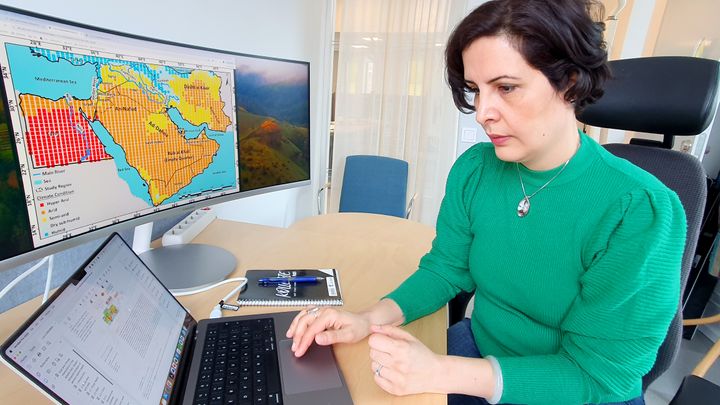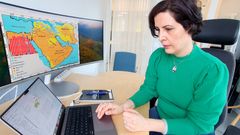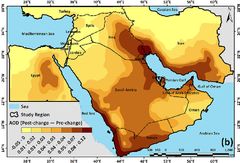Climate is one culprit in spread and growth of Middle East dust levels
Climate change is transforming dust storms—a natural phenomenon in the Middle East—into a more frequent and widespread threat to health and economies throughout the region, a new study shows.

Dust levels have increased in many parts of the Middle East chiefly due to global warming, but other human activities also share credit, says Zahra Kalantari, associate professor at KTH Royal Institute of Technology in Stockholm. She cites such factors as oil extraction, military conflicts and lack of cross-border coordination of water management.
Published in the journal Science of the Total Environment, the study maps the spread of aerosolized dust, and pinpoints where and when trends in precipitation and evaporation have changed course for the worse.
Analyzing multiple sets of data over the last 40 years, the researchers found an increase in dust levels in Saudi Arabia, Iraq, Yemen, parts of Iran and Egypt and countries around the Persian Gulf, while it has declined in northern Iran and southwest Turkey.
Sharp increase in last 20 years
The area between the Tigris and Euphrates rivers in northern Iraq and along the Syria-Iraq border was reported to have the highest concentration of dust sources in the region, reflecting a sharp increase over the last 20 years.
The researchers documented a notable decrease in precipitation in northern Iraq, Syria, southwestern Iran, and southern Turkey. The natural effects of the area’s arid and hot climate have also been intensified by factors such as deforestation, dam building, over-irrigation and extraction of water and military conflict. Kalantari says one serious result is the reduction of soil moisture and vegetation coverage, which normally help reduce dust levels.
The environmental consequences include soil erosion, biodiversity loss and desertification, she says. Economic losses may result from damaged infrastructure, disrupted agriculture and reduced tourism.
Social disruption also can be expected, she says, and vulnerable populations will suffer disproportionately.
Kalantari says regional cooperation is vital to address complex factors and implement effective dust control measures. Comprehensive strategies are imperative to mitigate adverse effects on health, ecology, and socio-economic development.
The researchers call for “a comprehensive strategy focusing on environmental management and policy reforms.” Prescriptive measures include: reforestation, soil conservation, water conservation, regional cooperation, sustainable urban planning, advanced monitoring systems, public awareness campaigns and climate adaptation measures.
“These efforts, combined with research and cross-border collaboration, are essential for a sustainable environment that is resilient to dust storms in the Middle East,” Kalantari says.
Images



Subscribe to releases from KTH Royal Institute of Technology
Subscribe to all the latest releases from KTH Royal Institute of Technology by registering your e-mail address below. You can unsubscribe at any time.
Latest releases from KTH Royal Institute of Technology
1,000 times smaller than a grain of sand—glass sensors 3D-printed on optical fiber15.5.2024 15:06:46 CEST | Press release
In a first for communications, researchers in Sweden 3D printed silica glass micro-optics on the tips of optic fibers—surfaces as small as the cross section of a human hair. The advance could enable faster internet and improved connectivity, as well as innovations like smaller sensors and imaging systems.
Device improves stem cell generation and chance for accessible Alzheimer’s cell therapy24.4.2024 20:18:16 CEST | Press release
Researchers in Sweden say they have improved on a technique for converting regular skin cells into neural stem cells—an advance which they say helps close the gap for accessible personalized cell-based therapies for Alzheimer's and Parkinson's.
Global warming and plastic pollution entwined in vicious circle, report says19.3.2024 10:56:01 CET | Pressmeddelande
Typically viewed as unrelated problems, global warming and plastic pollution are instead inextricably trapped in a “vicious circle” where one feeds the other, researchers in Sweden report in Nature Communications. The mutually-reinforcing relationship escalates global warming, the degradation of materials, plastic waste and the leaching of toxic chemicals into the biosphere.
New hydrogen producing method is simpler and safer7.3.2024 13:57:26 CET | Press release
Researchers in Sweden unveiled a new concept for producing hydrogen energy more efficiently, splitting water into oxygen and hydrogen without the dangerous risk of mixing the two gases.
Deep learning tool may help cut emissions caused by air resistance5.3.2024 12:45:50 CET | Press release
Aerodynamic drag is a major contributor to global emissions. Here’s how a recent development in deep learning can help reduce it.
In our pressroom you can read all our latest releases, find our press contacts, images, documents and other relevant information about us.
Visit our pressroom